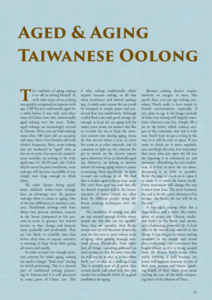
 |
|
The tradition of aging oolong is as old as oolong Herself. As with other types of tea, oolong was quickly recognized to improve with age. Cliff Tea was traditionally aged for a while before it was sold, and other areas of China have also intentionally aged oolong over the years. Today, aged oolongs are increasingly revered in Taiwan, where you can find oolongs more than 100 years old on occasion and more than a few decades old with relative frequency. Here, some oolong teas are marketed as "aged" after as few as six years, but most tea connoisseurs consider an oolong to be truly aged once it's 20-30 years old. Unless they're stored in poor conditions, most oolongs will become incredible if you simply wait long enough to drink them.
All other factors being equal, more oxidized, darker-roast oolongs have an advantage over the greener oolongs when it comes to aging. One of the key differences is moisture content. Traditional oolongs only have about two percent moisture content in the leaves (compared to five percent or more in greener, less roasted leaves), so they change and ferment more gradually and predictably. They are less likely to crumble into dust before their time or require excessive re-roasting to keep them from going all musty and moldy.
In order to have low enough moisture content for stable aging, oolong tea needs a longer "final roast" during its initial processing. This is a natural part of traditional oolong processing in Taiwan and it is still practiced in some parts of China, too. This is why oolong traditionally didn't require vacuum sealing, or all that extra machinery and wasted packaging. A stable roast meant the tea could be wrapped in simple paper and preserved that way indefinitely. Although a solid final roast and good storage are enough to keep the tea aging well for many years, many tea masters also like to re-roast the tea to keep the moisture content low during aging. Some do this several times a year, or every five years or at other intervals, and it's common to light up the charcoal fire pit or switch on the electric roaster upon discovery of an accidentally aged tea. However, we belong to another school of oolong aging when it comes to roasting. More specifically, we don't re-roast our oolongs at all. We find that it makes aged oolongs taste more like roast than aged tea, and that the tea doesn't respond well to the inconsistencies of roasts (which are often done by different people using different roasting techniques over the years).
The instability of oolong teas that are not roasted enough is why many people say that they are not ageable. Since they are unstable, their flavor, aroma and Qi will fluctuate drastically over the first ten or even twenty years of aging, often passing through awkward phases. Eventually, Time stabilizes all things, including awkward tea (and teenagers), but for some time the tea will not be as nice as it was when fresh, nor as nice as a well-aged tea. This is actually true of all green teas, certain puerh and other teas that you would not ordinarily think of as good candidates for aging.
Because oolong doesn't require moisture or oxygen to store, like puerh does, you can age oolong anywhere. Puerh really is best stored in humid environments, especially if you plan to age it for longer periods of time, but oolong will happily transform wherever you live. Simply fill a jar to the brim, which reduces oxygen in the container, and seal it with wax. You'll want to put a string in the wax so it will be easy to open. If you want to check on it more regularly, you can forgo the wax, but remember that every time you open the lid you are exposing it to unwanted air and moisture - disturbing the tea's meditation. It is best to leave the tea alone, disrupting it as little as possible. Resist the urge to check on it, open it or shake it to smell the leaves inside. Every movement will change the way it tastes years later. The more hermetic the seal is for the entire duration of its storage, the better the tea will be in the end.
A fine aged oolong often has a clear surface and a color like amber, notes of prune and Chinese medicinal herbs in the flavor and aroma, and a balancing, powerful Qi. It feels silky in the mouth and smooth in the throat. It has huigan (a minty-cooling sensation in the mouth and throat after swallowing) and a sweetness that lingers almost as if it is being exuded from the throat. You'll know when you're brewing it well because the leaves will begin to murmur to you of their past, present and future, speaking kindly of their many years spent circling the sun, all the while whispering hints of the illusion of Time...